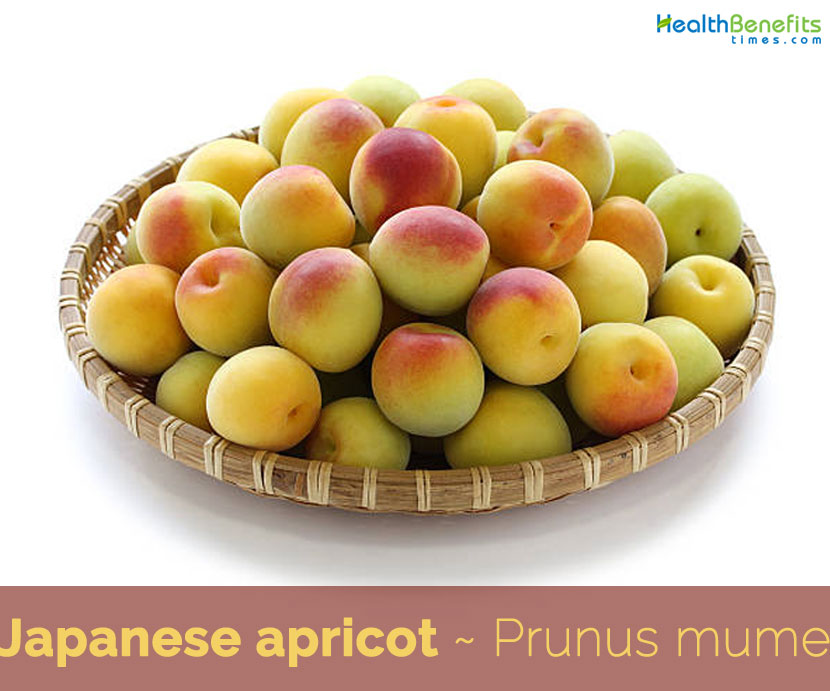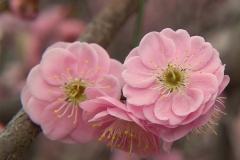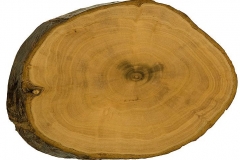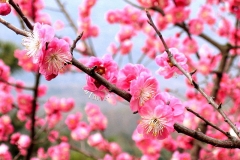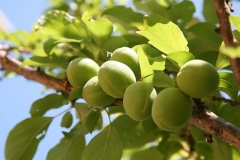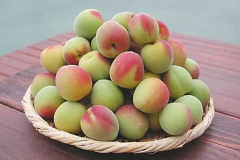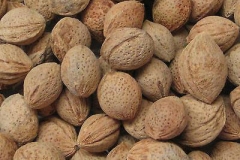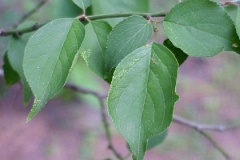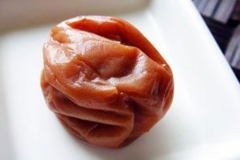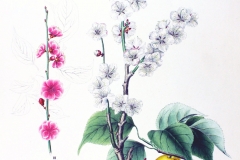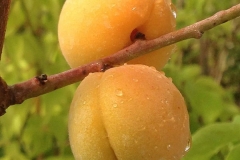| Japanese apricot Quick Facts | ||
|---|---|---|
| Name: | Japanese apricot | |
| Scientific Name: | Prunus mume | |
| Origin | China (western Sichuan and western Yunnan), Japan, Korea, north Laos and north Vietnam | |
| Colors | Green when young turning to yellow, sometimes with a red blush, as it ripens | |
| Shapes | Drupe is 2–3 centimeters (0.79–1.18 in) in diameter with a groove running from the stalk to the tip | |
| Flesh colors | Yellow | |
| Taste | Sour to bitter | |
| Health benefits | Beneficial for bronchitis, chronic coughs, chronic diarrhea, roundworms, fungal skin infections, corns, warts, gastrointestinal cramps, intestinal disorders, insomnia, menopausal symptoms, cancer, and prevention of heart disease | |
| Leaf | Flower | Fruit |
| Leaf arrangement: Alternate | Color: White or red through all kind of pink, single or double | Fruit shape: Round |
| Leaf type: Simple | Flower Characteristics: Showy and very fragrant | Fruit length: 1 to 3 inches |
| Leaf margin: Serrate | Fruit covering: Fleshy | |
| Leaf shape: Ovate | Fruit Color: Yellow | |
| Leaf venation: Pinnate | Fruit characteristics: Attracts birds; eatable but mostly showy | |
| Leaf type and persistence: Deciduous | ||
| Leaf blade length: 2 to 4 inches | ||
| Leaf Color: Green | ||
| Fall color: No color change | ||
| Fall characteristics: Not showy |
Health benefits of Japanese Apricot
Listed below are few of the popular health benefits of consuming Japanese apricot
1. Heart Health
Japanese plum juice concentrate was found to help improve the ability of blood flow through the body. The fruit juice concentrate of Japanese plum was found to promote a healthy environment for the formation of smooth muscle cells in the heart. It was also found to protect heart cells from the damaging effects of reactive oxygen species. Reactive oxygen species are a natural byproduct of cellular metabolism that are extremely reactive in the body and can be damaging to cells.
2. Human Influenza A
According to one research Japanese plum extract has also been found to protect against the flu. However, it was only found to be protective against getting the flu before being exposed to the virus. It did not have an effect on reduction of flu-like symptoms after it was already contracted. Researchers suspect that the efficacy of the plum extract has to do with its lectin-like qualities, which allow it to bind to substances in the blood, preventing it from infecting its host.
3. Gastrointestinal health
Japanese plum has also been observed to reduce infection and inflammation in cases of people with chronic atrophic gastritis caused by helicobactor pylori infection. Helicobactor pylori is a bacterium that causes the inner lining of the stomach to become chronically inflamed, and causes ulcers. Research has found that less helicobactor pylori were present in the stomach through tissue surgery in a sample of 68 adults.
Traditional uses and benefits of Japanese apricot
- Unripe fruit is antibacterial, anti-pyretic, antispasmodic, astringent, carminative, cholagogue, pectoral, sialagogue and vermifuge.
- Fruit has a broad-spectrum antibacterial activity.
- Unripe fruit of the tree is used for its antibacterial properties in the treatment of bronchitis, chronic coughs, chronic diarrhea and roundworms.
- Fruit is also used in the treatment of diarrhea and dysentery, to stop bleeding and to ease coughs.
- Half-ripe smoked fruit is considered to be antispasmodic, carminative and febrifuge.
- In small amounts this exceedingly poisonous compound stimulates respiration, improves digestion and gives a sense of well-being.
- Smoked Japanese apricot fruits are useful for alleviating gastrointestinal cramps and suppressing intestinal contractions.
- Japanese apricot is supposed to be effective against parasites, stopping ulcers, and promoting a strong digestive system and heart.
- It is also used to treat chronic fatigue syndrome.
- When applied externally, Japanese apricot is used to treat infections, corns, and warts.
- Japanese apricot can also be used for fever, cough, stomach and intestinal disorders, insomnia, menopausal symptoms, cancer, and prevention of heart disease.
- It is also used for detoxification and thirst.
- Japanese apricot is occasionally applied directly to the skin for sunburn.
- Traditionally, the fruit is used to treat indigestion, roundworms, dysentery, bronchitis, chronic coughs, fungal skin infections, and to stop bleeding.
Culinary Uses
- Fruit can be consumed raw or cooked.
- It is, however, extensively used in the Orient where it is usually pickled and then used as a condiment and a vegetable.
- It is conserved in salt and used as a relish in rice dishes etc.
- Flowers are used as a flavoring in tea.
- Seed can be consumed raw or cooked. Do not eat the seed if it is too bitter.
- In Korea, both the flowers and the fruits are used to make tea.
- In Japan, similar drink made from green plums, tastes sweet and tangy, is considered a cold, refreshing drink and is often enjoyed in the summer.
- Thick, sweet Chinese sauce called meijiang or meizijiang, usually translated as “plum sauce”, is also made from the plums, along with other ingredients such as sugar, vinegar, salt, ginger, chili, and garlic.
- It is used as a condiment for various Chinese dishes, including poultry dishes and egg rolls.
- In Korea, maesil-cheong, anti-microbial syrup made by sugaring ripe plums, is used as a condiment and sugar.
- In Korea, hwajeon can be made with plum blossoms. Called maehwa-jeon, the pancake dish is usually sweet, with honey as an ingredient.
- Plum liquor, also known as plum wine, is popular in both Japan and Korea, and is also produced in China.
- In Chinese cuisine, plums pickled with vinegar and salt are called suanmeizi, and have an intensely sour and salty flavor.
- Sour juice left over from the salting process is sometimes used as a vinegar substitute.
- Fruits can also be made into wine and various sauces.
- Sauce made from the fruits is sold as plum sauce in Chinese markets.
Dosing considerations for Japanese Apricot
The appropriate dose of Japanese apricot depends on several factors such as the user’s age, health, and several other conditions. At this time there is not enough scientific information to determine an appropriate range of doses for Japanese apricot. Keep in mind that natural products are not always necessarily safe and dosages can be important. Be sure to follow relevant directions on product labels and consult your pharmacist or physician or other healthcare professional before using.
Other Facts
- Green dye can be obtained from the leaves.
- Dark grey to green dye can be obtained from the fruit.
- Tree is cultivated for its fruit and flowers.
- In manufacturing, Japanese apricot is added to cosmetic lotions.
- Oil obtained from the seed is suitable for use in light industry.
- Plant is used for the production of beads. This probably refers to the seed.
- Wood is of high quality, but is generally too small for commercial use.
- The blossoms are also the national flower of Taiwan.
- They have been portrayed in art forms including embroidery, paintings and ceramics.
- The 5-petalled blossoms are the floral symbol of the month of January.
References:
https://www.itis.gov/servlet/SingleRpt/SingleRpt?search_topic=TSN&search_value=506231#null
https://davesgarden.com/guides/pf/go/56638/
http://www.theplantlist.org/tpl1.1/record/rjp-7973
https://gd.eppo.int/taxon/PRNMM
https://npgsweb.ars-grin.gov/gringlobal/taxonomydetail.aspx?id=30048
https://pfaf.org/user/Plant.aspx?LatinName=Prunus+mume
https://plants.usda.gov/core/profile?symbol=PRMU5
https://www.iucnredlist.org/species/50026548/50026551
https://en.wikipedia.org/wiki/Prunus_mume


